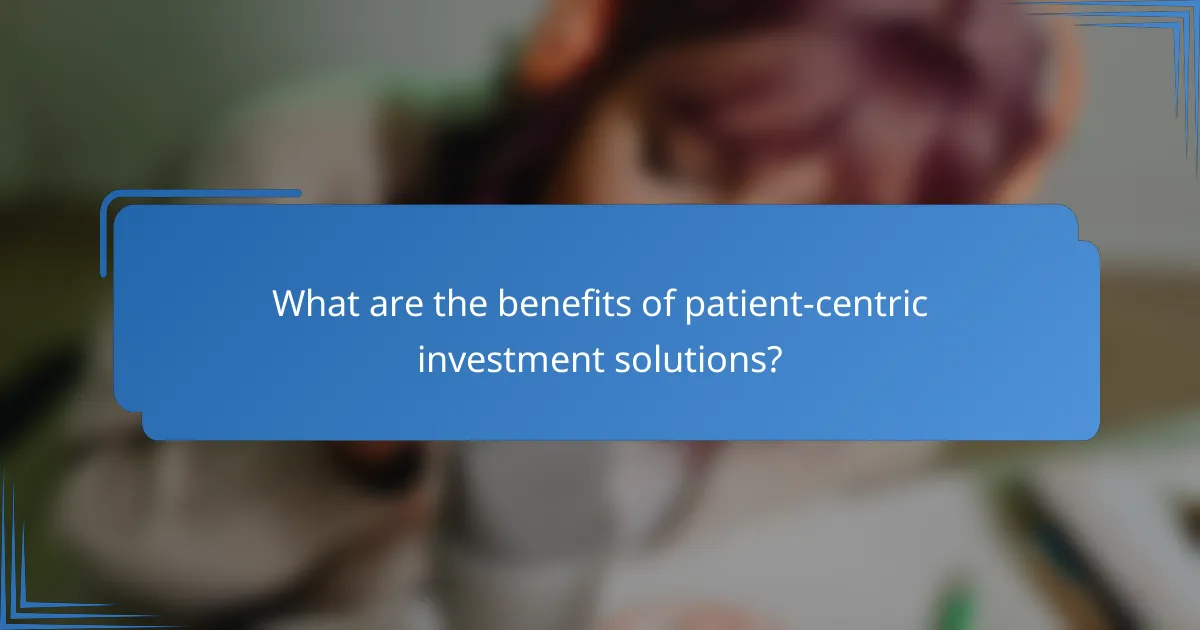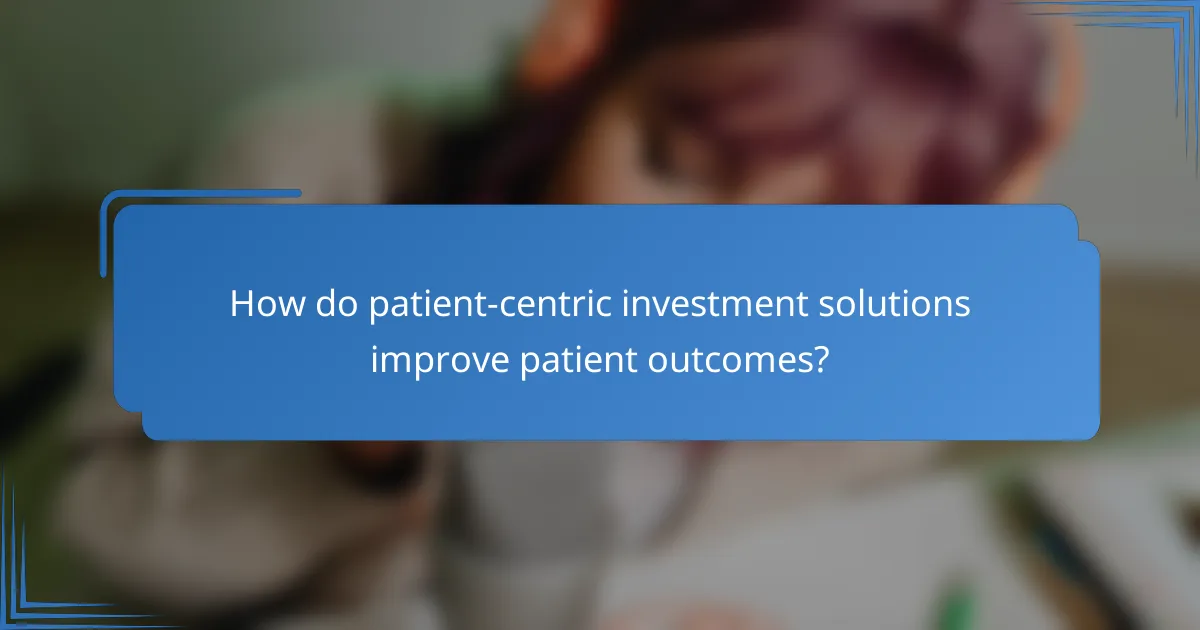Patient-centric investment solutions are transforming healthcare by placing the needs and preferences of patients at the forefront. By focusing on personalized care and leveraging advanced technologies, these solutions not only enhance care quality but also improve patient outcomes and satisfaction. This approach ensures that healthcare resources are allocated effectively, leading to a more responsive and effective healthcare system.

How can patient-centric investment solutions enhance care quality in Australia?
Patient-centric investment solutions can significantly enhance care quality in Australia by focusing on the needs and preferences of patients. By prioritizing patient experiences and outcomes, healthcare providers can allocate resources more effectively, integrate advanced technologies, and develop personalized treatment plans.
Improved resource allocation
Effective resource allocation is crucial for enhancing care quality. By investing in patient-centric solutions, healthcare organizations can identify areas where resources are most needed, ensuring that funds are directed towards services that improve patient outcomes. This may involve reallocating budgets to support preventive care, mental health services, or chronic disease management.
For example, hospitals might shift funding from less impactful services to programs that directly enhance patient engagement and satisfaction, such as telehealth services or patient education initiatives. This strategic allocation can lead to better health outcomes and increased patient loyalty.
Technology integration
Integrating technology into patient care is essential for improving quality. Patient-centric investment solutions often include the adoption of electronic health records (EHRs), telemedicine platforms, and mobile health applications. These technologies facilitate better communication between patients and healthcare providers, leading to more informed decision-making.
In Australia, the use of telehealth has surged, allowing patients in remote areas to access specialist care without the need for travel. This not only improves access but also enhances the overall patient experience by reducing wait times and increasing convenience.
Personalized treatment plans
Personalized treatment plans are a cornerstone of patient-centric care. By tailoring healthcare strategies to individual patient needs, preferences, and medical histories, providers can improve adherence to treatment and overall satisfaction. This approach often involves using data analytics to understand patient demographics and health trends.
For instance, a healthcare provider might develop a specific care plan for a patient with diabetes that includes personalized dietary recommendations, medication management, and regular follow-ups. This targeted approach can lead to better health outcomes and a more engaged patient population.

What are the benefits of patient-centric investment solutions?
Patient-centric investment solutions enhance care quality by prioritizing the needs and preferences of patients. These solutions lead to improved patient outcomes and satisfaction, ultimately benefiting healthcare providers and stakeholders.
Increased patient satisfaction
Patient-centric investment solutions focus on tailoring healthcare services to meet individual patient needs, which significantly boosts satisfaction levels. By actively involving patients in their care decisions and respecting their preferences, healthcare providers can create a more positive experience.
For example, personalized treatment plans and flexible appointment scheduling can lead to higher satisfaction scores. Regular feedback mechanisms, such as surveys, can also help providers understand patient needs better and adjust services accordingly.
Better health outcomes
These investment solutions often result in better health outcomes by ensuring that care is aligned with patient preferences and needs. When patients feel valued and understood, they are more likely to adhere to treatment plans and engage in preventive care.
Research indicates that patient engagement can reduce hospital readmission rates and improve chronic disease management. For instance, involving patients in their care decisions can lead to better management of conditions like diabetes or hypertension.
Cost efficiency
Implementing patient-centric investment solutions can lead to cost efficiency for healthcare systems. By focusing on preventive care and personalized treatment, providers can reduce unnecessary procedures and hospitalizations, which often incur high costs.
For example, investing in telehealth services can lower operational costs while improving access for patients. Additionally, streamlined processes that prioritize patient needs can minimize waste and enhance resource allocation, ultimately benefiting both patients and providers financially.

How do patient-centric investment solutions improve patient outcomes?
Patient-centric investment solutions enhance patient outcomes by prioritizing the needs and preferences of individuals in healthcare settings. These approaches leverage data and technology to create tailored experiences that lead to better care quality and increased patient satisfaction.
Data-driven decision making
Data-driven decision making involves using analytics and patient data to inform healthcare strategies. By analyzing trends and outcomes, providers can identify effective treatments and allocate resources more efficiently. For example, hospitals can use data to determine which interventions lead to the best recovery rates for specific conditions.
Implementing data analytics tools can help healthcare organizations track patient progress and adjust care plans in real-time. This proactive approach not only improves outcomes but also reduces costs by minimizing unnecessary procedures.
Enhanced patient engagement
Enhanced patient engagement focuses on involving patients in their own care processes. This can be achieved through educational resources, shared decision-making, and communication platforms that allow for direct interaction with healthcare providers. Engaged patients are more likely to adhere to treatment plans and follow up on care recommendations.
For instance, mobile health applications can empower patients to monitor their health metrics and communicate with their care teams, fostering a sense of ownership over their health journey. This increased involvement often leads to improved satisfaction and better health outcomes.
Continuous feedback loops
Continuous feedback loops are essential for refining patient-centric strategies. By regularly collecting feedback from patients about their experiences and outcomes, healthcare providers can identify areas for improvement and adapt their services accordingly. This iterative process ensures that care remains aligned with patient needs.
For example, post-visit surveys can provide insights into patient satisfaction and highlight specific issues that need addressing. Establishing regular check-ins and feedback mechanisms can help maintain high standards of care and build trust between patients and providers.

What criteria should be considered when selecting investment solutions?
When selecting investment solutions, it is essential to consider alignment with patient needs, scalability, and regulatory compliance. These criteria ensure that the solutions not only enhance care quality but also improve patient outcomes and satisfaction.
Alignment with patient needs
Investment solutions should be tailored to meet the specific needs of patients. This involves understanding the demographics, preferences, and health challenges of the patient population served. For example, solutions that offer personalized care plans or telehealth options can significantly enhance patient engagement and satisfaction.
To assess alignment, gather feedback from patients through surveys or focus groups. This direct input can guide the selection of solutions that resonate with patients and address their unique requirements effectively.
Scalability of solutions
Scalability is crucial for investment solutions to adapt to changing patient volumes and care demands. Solutions should be able to grow without compromising quality or increasing costs disproportionately. For instance, a software platform that can handle a growing number of users or services is preferable to one that requires extensive reconfiguration as demand increases.
When evaluating scalability, consider whether the solution can integrate with existing systems and expand its capabilities over time. This flexibility can save costs and streamline operations as the healthcare environment evolves.
Regulatory compliance
Ensuring that investment solutions comply with relevant regulations is vital for maintaining operational integrity and avoiding legal issues. Familiarity with healthcare regulations, such as HIPAA in the United States or GDPR in Europe, is essential when selecting solutions that handle patient data.
To ensure compliance, conduct thorough due diligence on potential solutions. Verify that vendors have robust security measures in place and are knowledgeable about the regulatory landscape. This proactive approach can mitigate risks and enhance trust among patients and stakeholders.

How do investment solutions impact healthcare satisfaction metrics?
Investment solutions significantly influence healthcare satisfaction metrics by enhancing the quality of care and improving patient outcomes. By allocating resources effectively, healthcare providers can optimize services, leading to higher patient satisfaction and better overall experiences.
Measurable patient feedback
Measurable patient feedback is crucial for assessing satisfaction levels in healthcare settings. Surveys, focus groups, and online reviews provide direct insights into patient experiences, allowing providers to identify strengths and areas for improvement. Regularly collecting and analyzing this feedback helps ensure that care delivery aligns with patient expectations.
For instance, using standardized patient satisfaction surveys can yield quantifiable data on aspects like wait times, staff interactions, and treatment effectiveness. This data can then be used to make informed decisions about resource allocation and service enhancements.
Benchmarking against industry standards
Benchmarking against industry standards allows healthcare organizations to compare their performance with peers and identify best practices. By evaluating metrics such as patient satisfaction scores, readmission rates, and treatment outcomes, providers can gauge their effectiveness relative to established benchmarks.
For example, if a hospital’s patient satisfaction score is significantly lower than the national average, it may indicate a need for targeted improvements. Utilizing resources like the Hospital Consumer Assessment of Healthcare Providers and Systems (HCAHPS) can provide valuable insights for this benchmarking process.

What emerging trends are shaping patient-centric investment solutions?
Emerging trends in patient-centric investment solutions focus on enhancing care quality and improving patient outcomes through innovative technologies and personalized approaches. These trends prioritize patient satisfaction and aim to create a more responsive healthcare system.
Telehealth advancements
Telehealth advancements are revolutionizing patient-centric investment solutions by providing remote access to healthcare services. This technology allows patients to consult with healthcare providers from the comfort of their homes, which can lead to increased satisfaction and better health outcomes.
Key considerations for implementing telehealth include ensuring robust cybersecurity measures, understanding reimbursement policies, and integrating telehealth platforms with existing healthcare systems. For instance, many insurers now cover telehealth visits, making it a financially viable option for both patients and providers.
To maximize the benefits of telehealth, healthcare organizations should invest in user-friendly platforms and provide training for both staff and patients. Avoid common pitfalls such as inadequate technical support and unclear communication about telehealth services, which can hinder patient engagement.
